05 June 2023: Database Analysis
Exploring Three Decades of Progress: A Comprehensive Visual Review of Intravoxel Incoherent Motion MRI Research (1988–2021)
Youwei Li1ABCE, Yuanfang Zhang1E, Honglin Shang2E, Qiang Gao3B, Qiping Wen1F, Na Chen4D, Mingchun Zhai1B, Jingxin Liu1B, Zhichao Zhou5C, Guanying Yang6C, Wei Wang1D, Zhongming Zhang7A*, Jianing Xi8ACEFGDOI: 10.12659/MSM.938715
Med Sci Monit 2023; 29:e938715
Abstract
BACKGROUND: Despite an increasing number of published articles on intravoxel incoherent motion (IVIM) in the past decade, almost all have focused on the technique and clinical applications of IVIM, with little attention to the collective knowledge and scientific analysis of this field. The aim of the present study was to construct a knowledge framework and to explore hotspots and emerging trends concerning use of IVIM in humans.
MATERIAL AND METHODS: The articles concerning IVIM MRI published from 1988 to 2021 were retrieved from the Science Citation Index Expended of the Web of Science Core Collection on 17, August 2021. The downloaded data were imported into Excel 2016 and CiteSpace V for scientometric analysis.
RESULTS: A total of 921 articles were included in this study and most of them were published since 2012. China (n=392) was the most productive country and the Philips Healthcare (n=46) was the most productive institution. Christian Federau had the largest number of publications (n=18). An article by Andreou A et al (2013) was the most important reference with the most co-citations (n=100) and centrality (0.06). The 5 hotspots in IVIM were perfusion, diffusion-weighted imaging, intravoxel incoherent motion, apparent diffusion coefficient, and magnetic resonance imaging. The 2 frontier topics were “brain perfusion” and “accuracy”. According to the clustering of co-citation analysis, “liver”, “diffusion weighting”, “pancreas”, and “brain” were the main research directions.
CONCLUSIONS: Scientometric analysis of IVIM literature with CiteSpace software can provide researchers with valuable information about knowledge framework, hotspots, and emerging trends concerning IVIM in humans.
Keywords: Diffusion, Magnetic Resonance Imaging, Humans, Motion, Diffusion Magnetic Resonance Imaging, Abdomen, Pancreas, Perfusion
Background
Microcirculation plays an important role in maintaining homeostasis of the cardiovascular system, delivering oxygen and nutrients, removing waste, and immune system signaling [1–4]. Microvascular dysfunction is associated with numerous diseases [5–7]. Therefore, quantitative assessment of microcirculatory physiology and pathophysiology will help in diagnosis and management of these diseases.
Perfusion imaging, especially magnetic resonance perfusion imaging (MRPI), has become an important means to evaluate microcirculation [8,9]. MRPI has 2 categories: contrast-enhanced (CE) imaging and contrast-free imaging. CE MRI methods, including dynamic susceptibility contrast and dynamic contrast-enhanced imaging, provide quantitative and functional information on the microenvironment of a tissue [10]. However, both techniques require intravenous administration of gadolinium-based contrast agents, which can cause adverse effects such as anaphylactic reaction, nephrogenic systemic fibrosis, and gadolinium deposition in the brain and other tissues [11–13].
The contrast-free MRPI includes arterial spin labeling (ASL) and intravoxel incoherent movement (IVIM). ASL uses magnetically labeled blood water as an endogenous contrast [14]. IVIM was originally defined as “
Because it does not use contrast agents and it provides additional information about microvasculature, IVIM is widely used throughout the body and for various diseases. Especially for oncology, IVIM demonstrated its potential for the differential diagnosis of malignant and benign tumors, or staging of malignant tumors, or the prognosis, or treatment evaluation [17–20].
Despite an increasing number of IVIM articles in the past decade, almost all focused on the technique and clinical applications of IVIM, with little attention paid to the collective knowledge and scientific analysis of this field.
Information visualization is commonly used to reveal the relationships among data and to disclose hidden features. As a branch of informatics, scientometrics uses science-mapping tools to analyze the published literature to build a knowledge structure and explore research hotspots and trends of an interesting field [21]. Compared with other science-mapping tools, CiteSpace software has can perform multivariate statistical analysis, cluster analysis, word frequency analysis, and social network analysis, and focuses on the evolution of trends and research frontiers [22]. Therefore, it has been applied widely in many research fields [23–27].
In this study, CiteSpace was applied to construct a knowledge framework and explore hotspots and emerging trends concerning IVIM in humans from 1988 to 2021.
Material and Methods
DATA COLLECTION:
We searched the Web of Science Core Collection (WoSCC) on 17 August 2021 for relevant articles published 1988–2021, using the retrieval strategy: Topic=(“intravoxel incoherent motion MR imaging” OR “IVIM”) AND English.
The searched articles were refined in document types, and only the data of articles and reviews were downloaded from WoSCC in full-recorded and references, plain-text format. The literature feature clustering included the title, abstract, keyword, source publication, authors’ name, institution, and country, year of publication, and references. Two reviewers independently assessed the downloaded data, with a decision made by the third reviewer if there was disagreement between the first 2 reviewers. Ethics approval and informed consent were not applicable in this study.
ANALYZING METHODS:
The downloaded data were imported into Microsoft (Bellevue, WA, USA) Excel 2016 and CiteSpace V (version 5.8.R1) for subsequent analysis. Excel 2016 was used to draw line graphs to display the number of published articles each year.
CiteSpace V was used to conduct cooperative network analysis for visualizing the collaboration of the authors, institutes and countries, to perform reference co-citation analysis and keywords co-occurrence analysis for studying the knowledge framework and research hotspots, and to perform burst keywords analysis for exploring research frontiers. The parameters of CiteSpace were: Time slicing from January 1988 to August 2021; Term source included title, abstract, author keywords, and keywords plus; Top N=30; and Cluster View-static and show Merged Network in Visualization, which merges the citation network of multiple time periods into a whole network. When the cooperation networks, which show the collaboration among authors, institutions, or countries, were analyzed, “years per slice”, which means the time span for each slice, was set 5 and minimum spanning tree for pruning. For reference co-citation analysis and keywords co-occurrence analysis, “years per slice” was 1 and pathfinder for pruning.
RESEARCH HOTSPOTS AND FRONTIERS:
Research hotspots were high-frequency keywords derived from co-occurrence keywords analysis [28,29] and frontiers explored by keywords burst detection [30]. Hotspot means the key research topic of scientific researchers in a certain period. Frontier means the latest published literature on a research topic, and the terms and phrases contained therein reflect the specific meaning of the research frontier. Research trends are displayed in a keywords time zone map.
Results
ARTICLES SELECTION AND PUBLICATION YEAR:
The total of 1057 articles published between 1988 and 2021 were retrieved by the initial search. After refining with “Article” and “Review”, 991 articles were included. Then, the abstract of each article was carefully reviewed by 2 reviewers, and 67 articles about animal experiments and 3 articles not related to IVIM were excluded. Therefore, 921 articles were included for the further analysis (Figure 1).
According to the publication trend (Figure 2), the number of articles on IVIM was relatively small from 1988 to 2011, with 1–5 articles annually. Since 2012, the number had rapidly grown, from 9 articles in 2012 to 131 in 2017. The yearly number of new publications now appears to have plateaued.
ANALYSIS OF AUTHOR COOPERATION: Network mapping of co-authorship showed that 921 articles were completed by 225 authors (Figure 3); 185 authors published than 5 articles each and the top 10 authors published at least 10 articles each. Christian Federau (18) ranked first, followed by Andreas Boss (17), Moritz C Wurnig (16), Martijn Froeling (14), Bram Stieltjes (13), Queenie Chan (11), Eric E Sigmund (11 articles), Yi Xiang J Wang (10), Changhong Liang (10), and Bachir Taouli (10). Christian Federau, Andreas Boss, and Moritz C Wurnig were in Switzerland; Queenie Chan, Yi Xiang J Wang, and Changhong Liang were in China; Eric E Sigmund and Bachir Taouli were in the USA; Martijn Froeling was in the Netherlands; and Bram Stieltjes was in Germany (Table 1). Their centralities were nearly zero, indicating relatively little cooperation among authors.
ANALYSIS OF INSTITUTION COOPERATION: We found that IVIM studies came from 135 institutions (Figure 4). The top 10 institutions are displayed in Table 2. Philips Healthcare published the most articles (46), followed by Fudan University (30), GE Healthcare (28), Siemens Healthcare (27), and Southern Med University (23). Shanghai Jiao Tong University, New York University, and the Sun Yat Sen University had 21 articles each, whereas Nanjing Medical University and Nanjing University had 18 articles each.
The New York University and the Nanjing Medical University had greater centrality, with 0.41 and 0.20, respectively.
ANALYSIS OF COUNTRY COOPERATION: There were 921 articles published by 43 countries (Figure 5). Among the top 10 countries (Table 2), China had the most articles (392), followed by USA (161), Germany (89), Japan (68), Switzerland (66), France (62), England (52), the Netherlands (44), South Korea (42), and Italy (42). In terms of centrality (more than 0.1), England had the highest centrality (0.42), followed by Switzerland (0.40), France (0.37), Germany (0.36), USA (0.29), Japan (0.16), and the Netherlands (0.11).
CO-CITATION REFERENCES ANALYSIS: There were 15 469 distinct references in co-citation references analysis. We used CiteSpace to create a network map of co-citation references with 654 nodes, 810 links, and main 37 clusters (Figure 6). The modularity Q 0.85 and the weighted mean silhouette 0.96 indicated that the clustering results were reasonable.
In the top 10 clusters (Table 3), “#0 liver” with 68 articles ranked first, followed by “#1diffusion weighting” (46), “#2pancreas” (44), “#3brain” (42), “#4magnetic resonance” (37), “#5experimental and brain ischemia” (32). “#6cardiac”, “#7cirrhosis”, “#8kidney diffusion” and “#9 post-test probability” had 30 articles.
The article published by Andreou A et al [28] was ranked first, with a citation count of 100, followed by Iima M et al [29] (96), Federau C et al [30] (72), and Koh DM et al [31] (69) (Table 4).
ANALYSIS OF CO-OCCURRENCE KEYWORDS: The map of co-occurrence keywords with 281 nodes and 586 links (Figure 7A) demonstrated that the keyword with the highest frequency was “perfusion” (414), followed by “diffusion-weighted imaging” (384), “intravoxel incoherent motion” (338), “apparent diffusion coefficient” (274), and “magnetic resonance imaging” (273), and the one with the highest centrality was “perfusion” (0.40), followed by “diffusion-weighted imaging” (0.34), “apparent diffusion coefficient” (0.26), “magnetic resonance imaging” (0.24), and “tumor” (0.23) (Table 5). The nodes are marked with purple circles representing important keywords.
The co-occurrence keyword clustering graph with an overall Q 0.52 and mean silhouette 0.91 (Figure 7B) showed 13 clusters of keywords. Four were associated with IVIM technique, including “#0IVIM”, “#1mri”, “#3bold”, and “#7epi”, and 9 were related to its application in the body such as “#2preliminary experience”, “#4renal”, “#5glioma”, “#6pca”, “#8renal cancer”, “#9pancreatic cancer”, “#10cerebral blood flow”, “#11kidney diffusion” and “#12pancreas” (Table 6).
As demonstrated by the time zone view (Figure 8), the earliest research direction was “diffusion-weighted imaging” in 1991, followed by “perfusion”, “intravoxel coherent motion”, and “magnetic resonance imaging” in 1992. The second peak keywords appeared from 2008 to 2016, including “parameter”, “b value”, “cancer”, “differentiation”, and “cirrhosis”.
ANALYSIS OF KEYWORD BURST:
The appearance time, burst strength, and time span of the top 17 keywords with the strongest citation bursts varied (Figure 9). From 1988 to 2021, the highest-strength burst keyword was “cirrhosis” (9.68), which began at 2013 and ended at 2015. “Brain perfusion” (3.72) and “accuracy” (4.12) were 2 keywords receiving great attention in recent years.
Discussion
GENERAL INFORMATION:
The trend of IVIM publications from 1988 to 2021 demonstrated 3 periods: the slowly developing period (1988 to 2011) with 48 articles (5%), which focused on the IVIM technique; the rapidly increasing period (2012 to 2017), when 9 articles in 2012 increased to 131 in 2017; and the plateau period (since 2018), with 130 articles per year. This trend was consistent with the development of IVIM techniques. The concept of IVIM was first introduced in 1986 by Le Bihan et al, who used IVIM effect combined with diffusion MRI, but IVIM effect and diffusion MRI was not applied in clinical practice until 1988 [29]. Unfortunately, its application was not popular due to MRI software and hardware limitations. After its coupling with echo planar imaging, the signal at multiple and higher b values could be acquired and IVIM became available [30] and was first used in a series of patients with liver lesions [31].
IVIM studies have been conducted in 43 countries and 135 institutions around the world. Although China and the USA published the most IVIM-related articles, England and Switzerland were central collaborators with other countries. In addition to Philips Healthcare, GE Healthcare, and Siemens Healthcare, 6 of the top 10 institutions were from China, and 1 from the USA. New York University and the Nanjing Medical University played an important role in the cooperation among research institutions. A total of 921 articles were written by 225 authors, but there was relatively little cooperation among authors.
KNOWLEDGE FRAMEWORK:
The co-citation network constitutes the knowledge base [32] and the most highly cited literature was the basic literature in the research field [33]. Thirty-seven clusters were obtained in the co-citation network, of which 15 were associated with IVIM technique such as “diffusion weighting”, “magnetic resonance”, and “dwi pseudo-diffusion”, and 22 were related to clinical applications, mainly on the brain, breasts, heart, liver, pancreas, kidneys, and prostate.
The top 10 references laid the foundation of IVIM research. From the IVIM basic theory and development history of Koh DM [30] and Lima M [28], IVIM imaging proposed by Le Bihan et al [29] was used to quantify the microcapillary perfusion of tissue of interest. To obtain the IVIM parameters, a two-compartment water diffusion model in a voxel was assumed. One was the “microvascular” compartment, where blood water diffusion depends on the velocity of blood and microvascular architecture, and the other was the “nonvascular” compartment, where water diffusion is exquisitely sensitive to the extravascular tissue structure. Given that water diffusion in 2 compartments yields the signal intensity on DWI, biexponential rather than mono-exponential fitting of the data was used to separate the perfusion from diffusion [29].
The b value was a key parameter of DWI and IVIM imaging. Three effects were observed under different b values. When the b value was below 200 s/mm2, the IVIM effect was higher than water true diffusion [34,35]. However, if the b value was above 200–400 s/mm2, IVIM effect was negligible and the Gaussian diffusion effect became stronger. As the b value increased up to 1500 s/mm2 or more, the water displacement distribution deviated from the Gaussian law and the non-Gaussian diffusion effect made the signal reach a “noise floor”, which needed more advanced models to handle this behavior, such as a kurtosis model [36], stretched exponential model [37], and others [38]. To extract 3 IVIM parameters, at least 4 different b values must be used theoretically. However, 4 b values were not possible to evaluate the parameter uncertainties, many studies used 4–10 b values. In addition, Lemke A et al [39] found that b value distributions can substantially minimize the overall measurement error.
Although IVIM effect can be used separately from DWI, it must be kept in mind that IVIM imaging cannot separate blood flow from flowing fluid in a voxel, such as CSF in the brain [40], tubular flow in the kidneys [41], and active transport from glandular secretion (breast ducts, salivary glands, and pancreas) [42].
Seven of the top 10 references reported classic empirical studies on IVIM. Dyvorne et al [43] optimized IVIM imaging by estimating the effects of diffusion gradient polarity and breathing acquisition scheme to detect hepatic fibrosis. Patel J et al [44] reported their preliminary experience in accurate diagnosis of cirrhosis. Woo S et al [45] and Andreou A et al [31] used IVIM parameters to evaluate hepatic carcinoma and metastases, respectively. In 2012, Federau C et al [41] found that IVIM parameters were sensitive to hyperoxygenation-induced vasoconstriction and hypercapnia-induced vasodilatation. Two years later, Federau C et al [30] republished an initial report about IVIM application in stroke, gliomas, metastasis, extra-axial tumor, and status epilepticus. Pang Y et al [46] revealed that IVIM imaging could also diagnose prostate cancer.
RESEARCH HOTSPOTS, FRONTIERS, AND EMERGING TRENDS:
According to the time zone map and keyword clustering, hotspots could be summarized into 3 main hotpots in different time. The hotspot in the first stage, from 1991 to 2000, focused on IVIM theory and technology such as “IVIM”, “mri”, “bold” and “epi”. The hotspot in the second stage from 2001 to 2007 were related to IVIM application in the body such as “blood flow”, “liver”, “model”, and “quantification”. The third stage was from 2008 to 2016, when optimized IVIM imaging had been paid more attention and the frequency of articles using the keywords “parameter” or “b values” increased. Recently, the keywords such as “brain perfusion” and “accuracy” increased dramatically and become a research frontier.
LIMITATIONS:
This study had some limitations. First, all the data were downloaded from the WoS database; therefore, some published studies were not included in this study. Second, all the literature analyzed in the present study were in English and those published in other language were excluded, which might have led to language bias. Finally, this study used co-occurrence keyword analysis to explore the hotspots and frontiers of IVIM research. Weaknesses of co-occurrence keyword analysis [47–49] may have failed to accurately assess some research hotspots, which need further study in the future.
Conclusions
Scientometric analysis of the IVIM literature provide researchers with valuable information about knowledge framework, hotspots, and emerging trends concerning IVIM in humans.
Figures
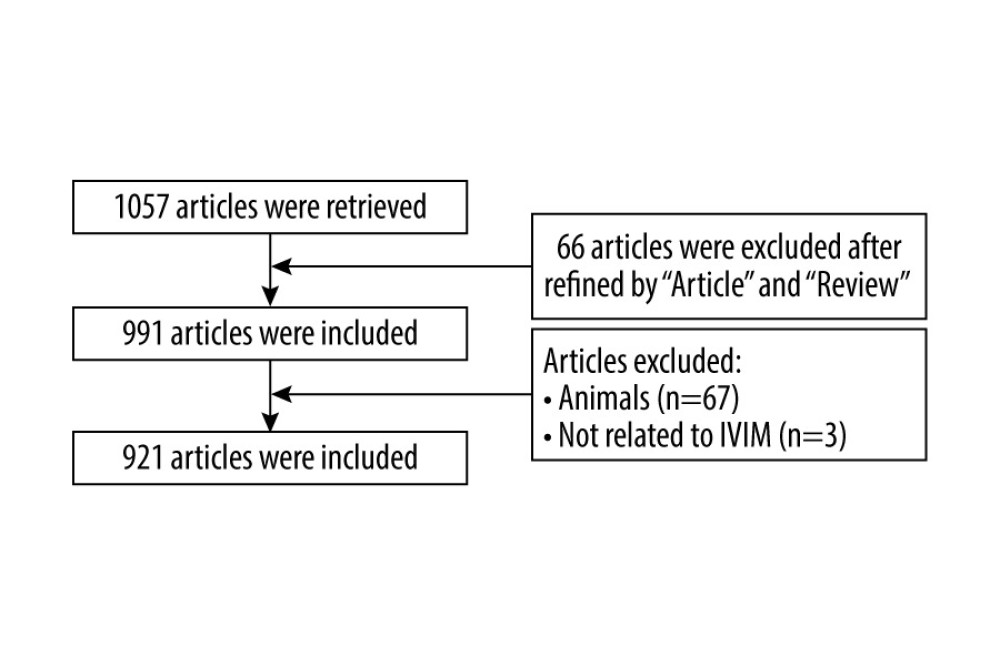 Figure 1. Flowchart of the search process for included articles. IVIM, intravoxel incoherent motion. Figure was created using Microsoft Word 2016.
Figure 1. Flowchart of the search process for included articles. IVIM, intravoxel incoherent motion. Figure was created using Microsoft Word 2016. 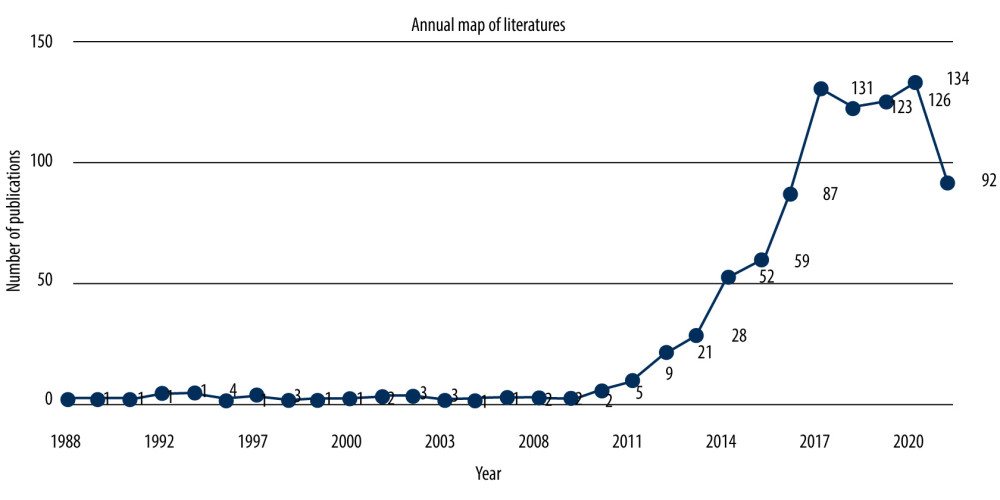 Figure 2. The number of published studies on IVIM since 1988 to 2021. Figure was created using Microsoft Excel 2016.
Figure 2. The number of published studies on IVIM since 1988 to 2021. Figure was created using Microsoft Excel 2016. 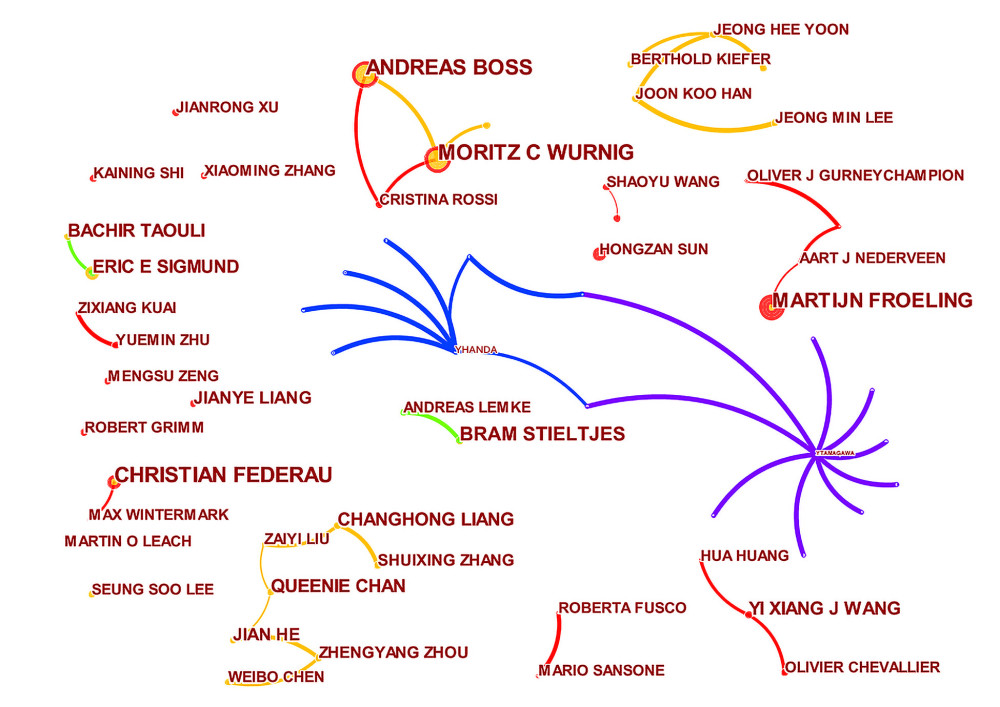 Figure 3. Map of author cooperation networks with 225 nodes and 175 links in IVIM from 1988 to 2021. It is notable that some small nodes were omitted automatically and only the main lines were shown. Each node represents an author and the size of node was proportional to the count of published articles. Each link represents the connection between nodes and the thickness of the links indicates the strength of the cooperation relationship. IVIM – intravoxel incoherent motion. Figure was created using CiteSpace V (version 5.8.R1), Podia.
Figure 3. Map of author cooperation networks with 225 nodes and 175 links in IVIM from 1988 to 2021. It is notable that some small nodes were omitted automatically and only the main lines were shown. Each node represents an author and the size of node was proportional to the count of published articles. Each link represents the connection between nodes and the thickness of the links indicates the strength of the cooperation relationship. IVIM – intravoxel incoherent motion. Figure was created using CiteSpace V (version 5.8.R1), Podia. 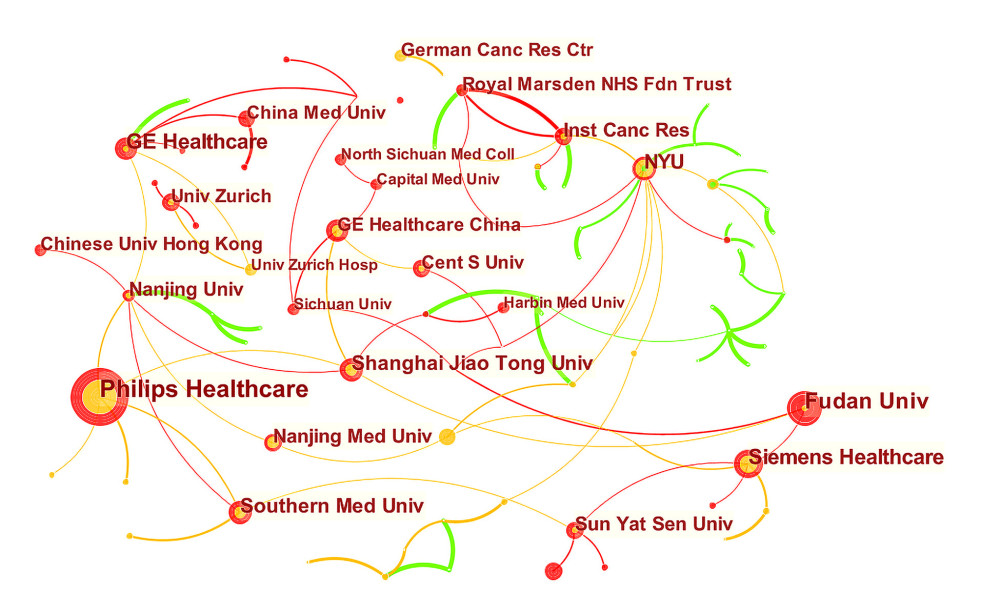 Figure 4. Map of institution cooperation networks with 135 nodes and 119 links in IVIM from 1988 to 2021. It is notable that some small nodes were omitted automatically and only the main lines were shown. Each node represents an institution and the size of node was proportional to the count of published articles. The purple rings of the node indicated greater centrality of the institutions. Each link represents the connection between nodes and the thickness of the links indicated the strength of the cooperation relationship. IVIM – intravoxel incoherent motion. Figure was created using CiteSpace V (version 5.8.R1), Podia.
Figure 4. Map of institution cooperation networks with 135 nodes and 119 links in IVIM from 1988 to 2021. It is notable that some small nodes were omitted automatically and only the main lines were shown. Each node represents an institution and the size of node was proportional to the count of published articles. The purple rings of the node indicated greater centrality of the institutions. Each link represents the connection between nodes and the thickness of the links indicated the strength of the cooperation relationship. IVIM – intravoxel incoherent motion. Figure was created using CiteSpace V (version 5.8.R1), Podia. 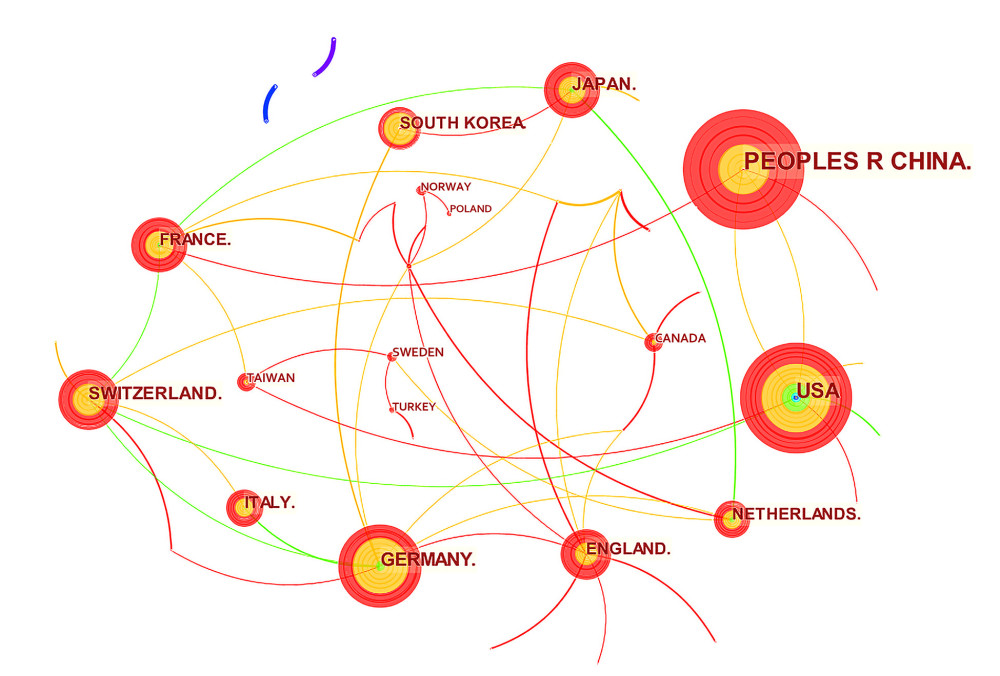 Figure 5. Map of country co-citation networks with 43 nodes and 55 links in IVIM from 1988 to 2021. Each node represents a country, and the size of node was proportional to the count of published articles. Each link represents the connection between nodes and the thickness of the links indicated the strength of the cooperation relationship. The purple rings of the node indicated greater centrality of the countries. IVIM – intravoxel incoherent motion. Figure was created using CiteSpace V (version 5.8.R1), Podia.
Figure 5. Map of country co-citation networks with 43 nodes and 55 links in IVIM from 1988 to 2021. Each node represents a country, and the size of node was proportional to the count of published articles. Each link represents the connection between nodes and the thickness of the links indicated the strength of the cooperation relationship. The purple rings of the node indicated greater centrality of the countries. IVIM – intravoxel incoherent motion. Figure was created using CiteSpace V (version 5.8.R1), Podia.  Figure 6. Cluster visualization of reference co-citation network with modularity Q 0.85 and mean silhouette 0.96 in the IVIM field from 1988 to 2021. The network was divided into 37 clusters. Clusters represented frequency keywords of publications. The smaller the sequence number of cluster, the higher the frequency. IVIM – intravoxel incoherent motion. Figure was created using CiteSpace V (version 5.8.R1), Podia.
Figure 6. Cluster visualization of reference co-citation network with modularity Q 0.85 and mean silhouette 0.96 in the IVIM field from 1988 to 2021. The network was divided into 37 clusters. Clusters represented frequency keywords of publications. The smaller the sequence number of cluster, the higher the frequency. IVIM – intravoxel incoherent motion. Figure was created using CiteSpace V (version 5.8.R1), Podia. 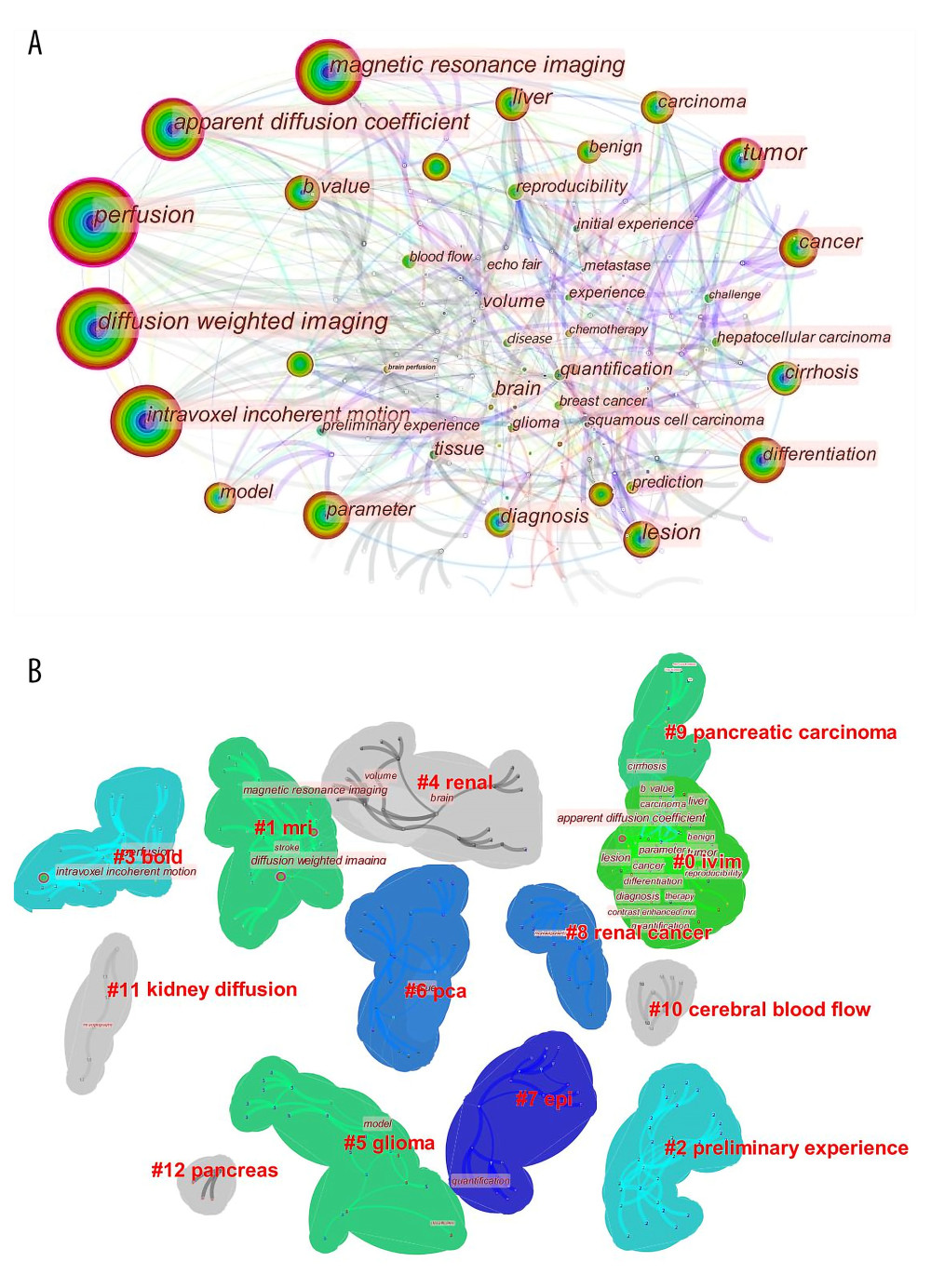 Figure 7. The co-occurrence keywords networks in the IVIM field from 1988 to 2021. (A) Map of the co-occurrence keywords with 281 nodes and 586 links. (B) Cluster analysis map of the co-occurrence keywords with modularity Q 0.52 and mean silhouette 0.91. The network was divided into 13 clusters. The convex hulls of different colors represented different clusters with the colors representing their appearing years. Clusters represented frequency keywords of publications. The smaller the sequence number of cluster, the higher the frequency. IVIM, intravoxel incoherent motion. IVIM – intravoxel incoherent motion. Figure was created using CiteSpace V (version 5.8.R1), Podia.
Figure 7. The co-occurrence keywords networks in the IVIM field from 1988 to 2021. (A) Map of the co-occurrence keywords with 281 nodes and 586 links. (B) Cluster analysis map of the co-occurrence keywords with modularity Q 0.52 and mean silhouette 0.91. The network was divided into 13 clusters. The convex hulls of different colors represented different clusters with the colors representing their appearing years. Clusters represented frequency keywords of publications. The smaller the sequence number of cluster, the higher the frequency. IVIM, intravoxel incoherent motion. IVIM – intravoxel incoherent motion. Figure was created using CiteSpace V (version 5.8.R1), Podia. 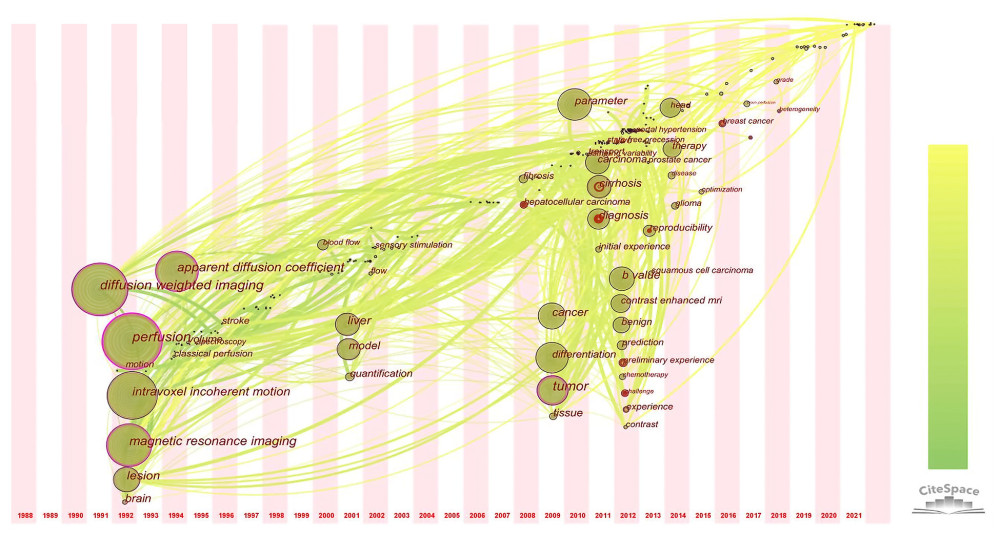 Figure 8. Time zone of the co-occurrence keywords in the IVIM field from 1988 to 2021. Deeper color indicates earlier studies. IVIM – intravoxel incoherent motion. Figure was created using CiteSpace V (version 5.8.R1), Podia.
Figure 8. Time zone of the co-occurrence keywords in the IVIM field from 1988 to 2021. Deeper color indicates earlier studies. IVIM – intravoxel incoherent motion. Figure was created using CiteSpace V (version 5.8.R1), Podia. 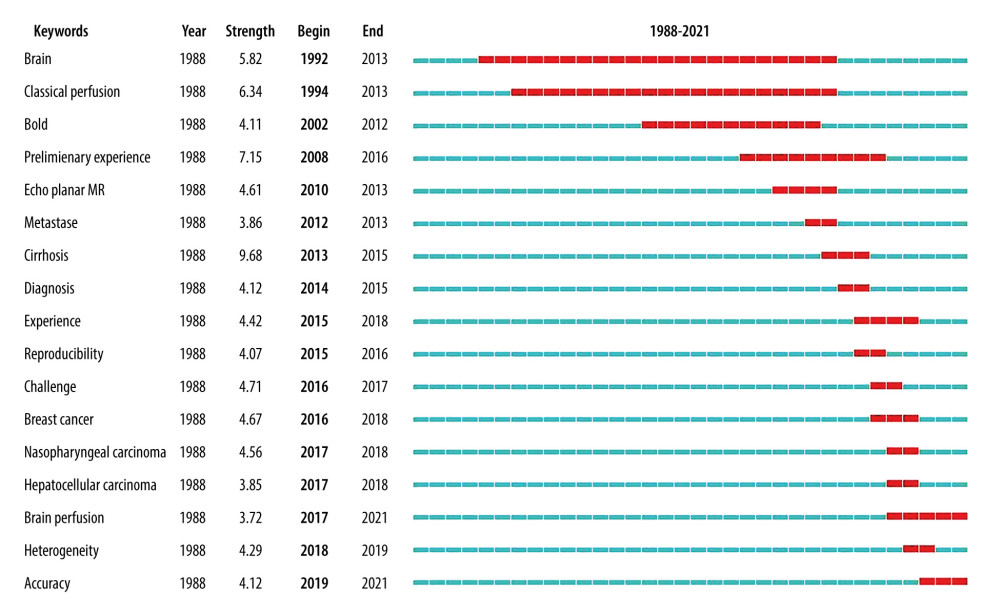 Figure 9. Top 17 Keywords with the Strongest Citation Bursts in IVIM. The green line shows the time period from 1992 to 2021, and the red line represents the time span of the keyword burst. IVIM – intravoxel incoherent motion. The year 1988 was the beginning time of retrieval. Figure was created using CiteSpace V (version 5.8.R1), Podia.
Figure 9. Top 17 Keywords with the Strongest Citation Bursts in IVIM. The green line shows the time period from 1992 to 2021, and the red line represents the time span of the keyword burst. IVIM – intravoxel incoherent motion. The year 1988 was the beginning time of retrieval. Figure was created using CiteSpace V (version 5.8.R1), Podia. Tables
Table 1. Top 10 authors from cooperation network who performed IVIM studies from 1988 to 2021.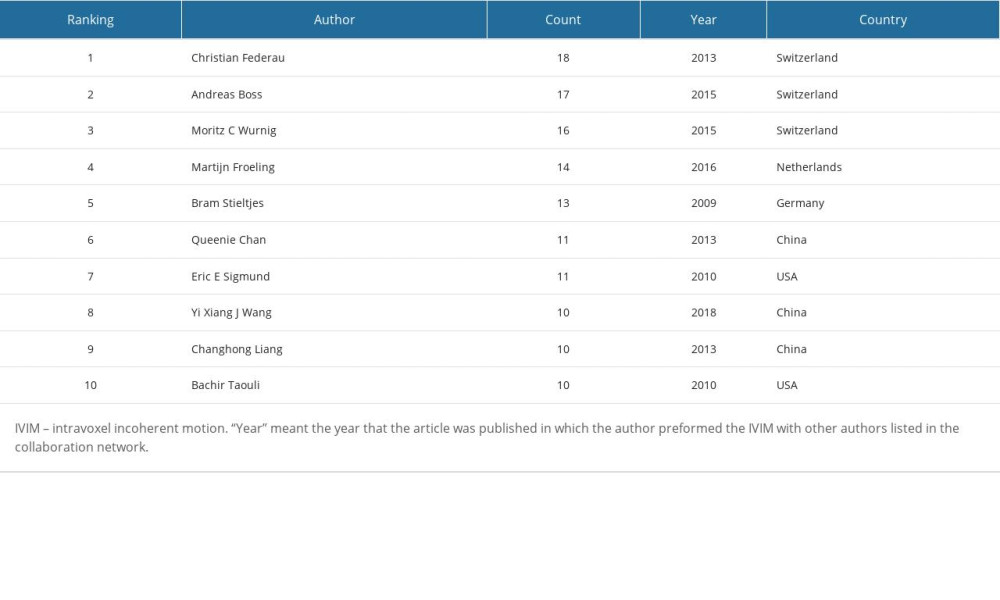 Table 2. Top 10 countries and institutions which performed IVIM studies from 1988 to 2021.
Table 2. Top 10 countries and institutions which performed IVIM studies from 1988 to 2021.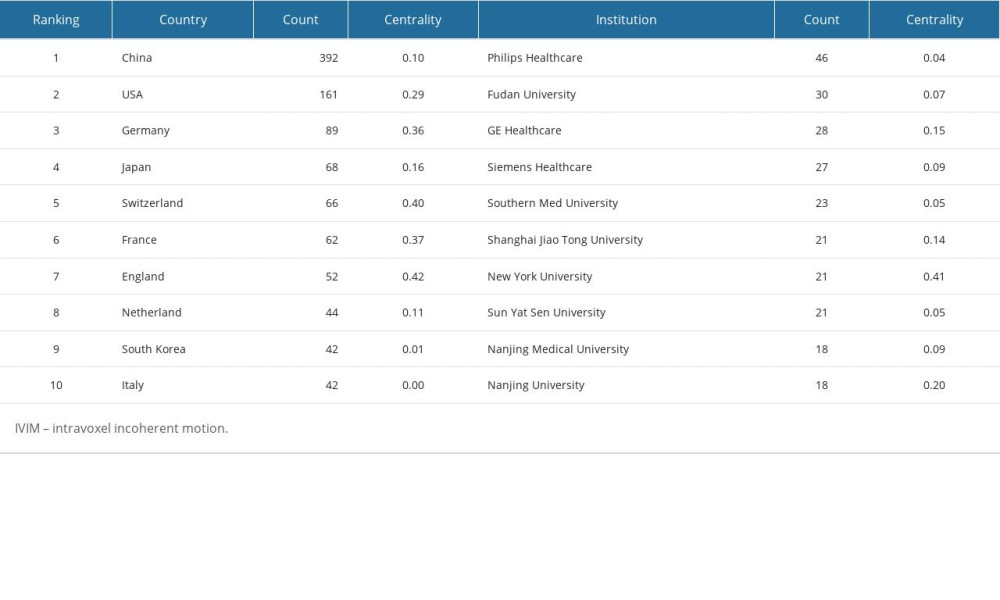 Table 3. Top 10 clusters of reference co-citation network in the IVIM field from 1988 to 2021.
Table 3. Top 10 clusters of reference co-citation network in the IVIM field from 1988 to 2021.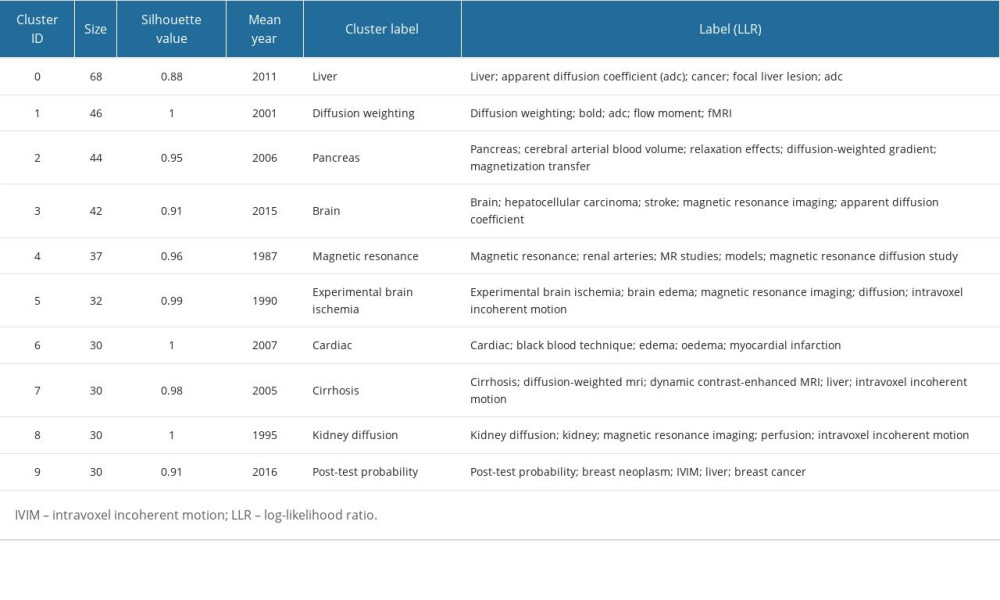 Table 4. Top 10 references with the most citation.
Table 4. Top 10 references with the most citation.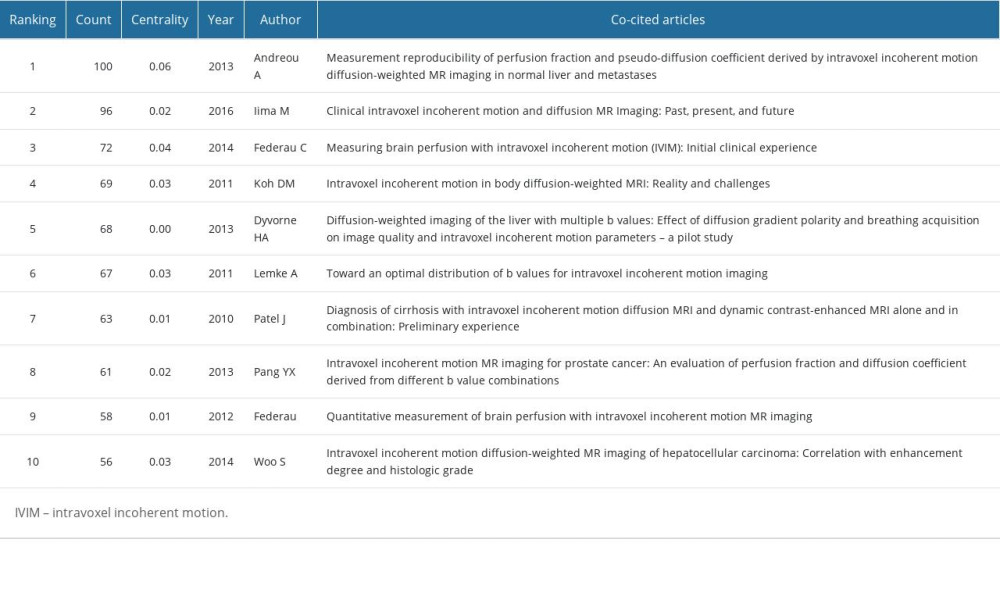 Table 5. Top 10 high frequency keywords and Top 10 high centrality keywords in the IVIM field from 1988 to 2021.
Table 5. Top 10 high frequency keywords and Top 10 high centrality keywords in the IVIM field from 1988 to 2021. Table 6. The 13 clusters of keywords in the IVIM field from 1988 to 2021.
Table 6. The 13 clusters of keywords in the IVIM field from 1988 to 2021.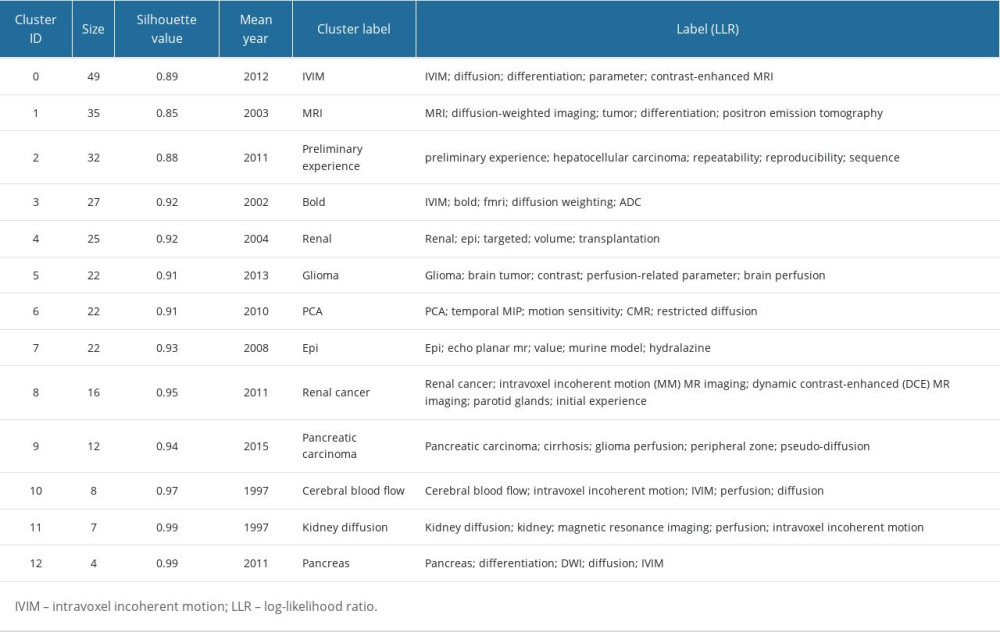
References
1. Guven G, Hilty MP, Ince C, Microcirculation: Physiology, pathophysiology, and clinical application: Blood Purif, 2020; 49(1–2); 143-50
2. Pittman RN, Oxygen transport in the microcirculation and its regulation: Microcirculation, 2013; 20; 117-37
3. Jacob M, Chappell D, Becker BF, Regulation of blood flow and volume exchange across the microcirculation: Crit Care, 2016; 20; 319
4. Danese S, Dejana E, Fiocchi C, Immune regulation by microvascular endothelial cells: Directing innate and adaptive immunity, coagulation, and inflammation: J Immunol, 2007; 178; 6017-22
5. Joffre J, Hellman J, Ince C, Ait-Oufella H, Endothelial responses in sepsis: Am J Respir Crit Care Med, 2020; 202; 361-70
6. Erdener SE, Dalkara T, Small vessels are a big problem in neurodegeneration and neuroprotection: Front Neurol, 2019; 10; 889
7. Fu BM, Tumor metastasis in the microcirculation: Adv Exp Med Biol, 2018; 1097; 201-18
8. Fass L, Imaging and cancer: A review: Mol Oncol, 2008; 2; 115-52
9. Guerraty M, Bhargava A, Senarathna J, Advances in translational imaging of the microcirculation: Microcirculation, 2021; 28; e12683
10. Lohrke J, Frenzel T, Endrikat J, 25 Years of contrast-enhanced MRI: Developments, current challenges and future perspectives: Adv Ther, 2016; 33; 1-28
11. Pullicino R, Radon M, Biswas S, A review of the current evidence on gadolinium deposition in the brain: Clin Neuroradiol, 2018; 28; 159-69
12. Chehabeddine L, AI Saleh T, Baalbaki M, Cumulative administrations of gadolinium-based contrast agents: Risks of accumulation and toxicity of linear vs macrocyclic agents: Crit Rev Toxicol, 2019; 49(3); 262-79
13. Kanda T, Ishii K, Kawaguchi H, High signal intensity in the dentate nucleus and globus pallidus on unenhanced T1-weighted MR images: Relationship with increasing cumulative dose of a gadolinium-based contrast material: Radiology, 2014; 270; 834-41
14. Deibler AR, Pollock JM, Kraft RA, Arterial spin-labeling in routine clinical practice, part 1: Technique and artifacts: Am J Neuroradiol, 2008; 29; 1228-34
15. Le Bihan D, Breton E, Lallemand D, MR Imaging of intravoxel incoherent motions: Application to diffusion and perfusion in neurologic disorders: Radiology, 1986; 161; 401-7
16. Federau C, Measuring perfusion: Intravoxel incoherent motion MR imaging: Magn Reson Imaging Clin N Am, 2021; 29; 233-42
17. Lima M, Perfusion-driven intravoxel incoherent motion (IVIM) MRI in oncology: Applications, challenges, and future trends: Magn Reson Med Sci, 2021; 20(2); 125-38
18. Wang YXJ, Huang H, Zheng CJ, Diffusion-weighted MRI of the liver: Challenges and some solutions for the quantification of apparent diffusion coefficient and intravoxel incoherent motion: Am J Nucl Med Mol Imaging, 2021; 11(2); 107-42
19. England EK, Reiter DA, Shahidi B, Sigmund EE, Intravoxel incoherent motion magnetic resonance imaging in skeletal muscle: Review and future directions: JMRI, 2021; 55(4); 988-1012
20. He N, Li Z, Li X, Intravoxel incoherent motion diffusion-weighted imaging used to detect prostate cancer and stratify tumor grade: A Meta-analysis: Front Oncol, 2020; 10; 1623
21. Chen C, Hu Z, Liu S, Tseng H, Emerging trends in regenerative medicine: A scientometric analysis in CiteSpace: Expert Opin Biol Ther, 2012(5); 593-608
22. Chen C, CiteSpace II: Detecting and visualizing emerging trends and transient patterns in scientific literature: J Am Soc Inf Sci Technol, 2006; 57; 359-77
23. Wang Z, Huang C, Li X, Research trends and hotspot analysis of conjunctival bacteria based on CiteSpace software: Biomed Res Int, 2020; 2020; 2580795
24. Liu S, Sun YP, Gao XL, Sui Y, Knowledge domain and emerging trends in Alzheimer’s disease: A scientometric review based on CiteSpace analysis: Neural Regen Res, 2019; 14(9); 1643-50
25. Guo S, Wang L, Xie Y, Bibliometric and visualized analysis of stem cells therapy for spinal cord injury based on web of science and CiteSpace in the last 20 years: World Neurosurg, 2019; 132; e246-e58
26. Zheng J, Zhou R, Meng B, Knowledge framework and emerging trends in intracranial aneurysm magnetic resonance angiography: A scientometric analysis from 2004 to 2020: Quant Imaging Med Surg, 2021; 11(5); 1854-69
27. Zhang J, Zhang Y, Hu L, Global trends and performances of magnetic resonance imaging studies on acupuncture: A bibliometric analysis: Front Neurosci, 2021; 14; 620555
28. Andreou A, Koh DM, Collins DJ, Measurement reproducibility of perfusion fraction and pseudodiffusion coefficient derived by intravoxel incoherent motion diffusion-weighted MR imaging in normal liver and metastases: Eur Radiol, 2013; 23(2); 428-34
29. Lima M, Le Bihan D, Clinical intravoxel incoherent motion and diffusion MR imaging: Past, present, and future: Radiology, 2016; 278(1); 13-32
30. Federau C, Obrien K, Meuli R, Measuring brain perfusion with intravoxel incoherent motion (IVIM): initial clinical experience: J Magn Reson Imaging, 2014; 39(3); 624-32
31. Koh DM, Collins DJ, Orton MR, Intravoxel incoherent motion in body diffusion-weighted MRI: Reality and challenges: Am J Roentgenol, 2011; 196(6); 1351-61
32. Chen C, Ibekwe-SanJuan F, Hou J, The structure and dynamics of cocitation clusters: A multiple-perspective cocitation analysis: J Am Soc Inf Sci, 2010; 61(7); 1386-409
33. Bo C, The hotspots, key trends and frontier themes in the studies of Chinese private tertiary education in the last twenty years – a bibliometric analysis based on CiteSpace: Modern Educational Management, 2017; 12; 14-21
34. Iima M, Yano K, Kataoka M, Quantitative non-Gaussian diffusion and intravoxel incoherent motion magnetic resonance imaging: Differentiation of malignant and benign breast lesions: Invest Radiol, 2015; 50(4); 205-11
35. Le Bihan D, Apparent diffusion coefficient and beyond: What diffusion MR imaging can tell us about tissue structure: Radiology, 2013; 268(2); 318-22
36. Chabert S, Meca C, Le Bihan D, Relevance of the information about the diffusion distribution in vivo given by kurtosis in q-space imaging [abstr], 2004; 1238, Berkeley, Calif, International Society for Magnetic Resonance in Medicine
37. Bennett KM, Schmainda KM, Bennett RT, Characterization of continuously distributed cortical water diffusion rates with a stretched-exponential model: Magn Reson Med, 2003; 50(4); 727-34
38. Zhou XJ, Gao Q, Abdullah O, Magin RL, Studies of anomalous diffusion in the human brain using fractional order calculus: Magn Reson Med, 2010; 63(3); 562-69
39. Lemke A, Stieltjes B, Schad LR, Laun FB, Toward an optimal distribution of b values for intravoxel incoherent motion imaging: Magn Reson Imaging, 2011; 29; 766-76
40. Federau C, Maeder P, O’Brien K, Quantitative measurement of brain perfusion with intravoxel incoherent motion MR imaging: Radiology, 2012; 265(3); 874-81
41. Thoeny HC, De Keyzer F, Oyen RH, Peeters RR, Diffusion-weighted MR imaging of kidneys in healthy volunteers and patients with parenchymal diseases: Initial experience: Radiology, 2005; 235; 911-17
42. Yoshino N, Yamada I, Ohbayashi N, Salivary glands and lesions: Evaluation of apparent diffusion coefficients with split-echo diffusion-weighted MR imaging – initial results: Radiology, 2001; 221; 837-42
43. Dyvorne HA, Galea N, Nevers T, Diffusion-weighted imaging of the liver with multiple b values: Effect of diffusion gradient polarity and breathing acquisition on image quality and intravoxel incoherent motion parameters – a pilot study: Radiology, 2013; 266(3); 920-29
44. Patel J, Sigmund EE, Rusinek H, Diagnosis of cirrhosis with intravoxel incoherent motion diffusion MRI and dynamic contrast-enhanced MRI alone and in combination: Preliminary experience: J Magn Reson Imaging, 2010; 31; 589-600
45. Woo S, Lee JM, Yoon JH, Intravoxel incoherent motion diffusion-weighted MR imaging of hepatocellular carcinoma: Correlation with enhancement degree and histologic grade: Radiology, 2014; 270(3); 758-67
46. Pang Y, Turkbey B, Bernardo M, Intravoxel incoherent motion MR imaging for prostate cancer: An evaluation of perfusion fraction and diffusion coefficient derived from different b-value combinations: Magn Reson Med, 2013; 69(2); 553-62
47. Li J, Chen CM: CiteSpace: Scientific text mining and visualization (second edition) (M), 2017, Beijing, Capital University of Economics and Business Press
48. Hu CP, Chen G, Characteristics of keywords in scientific papers and their impact on co-word analysis: Journal of the China Society for Scientific and Technical Information, 2014; 33(1); 23-32
49. Li G, Ba Z, Research on some problems in the process of co-word analysis: Journal of Library Science in China, 2017; 43(4); 93-113
Figures
 Figure 1. Flowchart of the search process for included articles. IVIM, intravoxel incoherent motion. Figure was created using Microsoft Word 2016.
Figure 1. Flowchart of the search process for included articles. IVIM, intravoxel incoherent motion. Figure was created using Microsoft Word 2016. Figure 2. The number of published studies on IVIM since 1988 to 2021. Figure was created using Microsoft Excel 2016.
Figure 2. The number of published studies on IVIM since 1988 to 2021. Figure was created using Microsoft Excel 2016. Figure 3. Map of author cooperation networks with 225 nodes and 175 links in IVIM from 1988 to 2021. It is notable that some small nodes were omitted automatically and only the main lines were shown. Each node represents an author and the size of node was proportional to the count of published articles. Each link represents the connection between nodes and the thickness of the links indicates the strength of the cooperation relationship. IVIM – intravoxel incoherent motion. Figure was created using CiteSpace V (version 5.8.R1), Podia.
Figure 3. Map of author cooperation networks with 225 nodes and 175 links in IVIM from 1988 to 2021. It is notable that some small nodes were omitted automatically and only the main lines were shown. Each node represents an author and the size of node was proportional to the count of published articles. Each link represents the connection between nodes and the thickness of the links indicates the strength of the cooperation relationship. IVIM – intravoxel incoherent motion. Figure was created using CiteSpace V (version 5.8.R1), Podia. Figure 4. Map of institution cooperation networks with 135 nodes and 119 links in IVIM from 1988 to 2021. It is notable that some small nodes were omitted automatically and only the main lines were shown. Each node represents an institution and the size of node was proportional to the count of published articles. The purple rings of the node indicated greater centrality of the institutions. Each link represents the connection between nodes and the thickness of the links indicated the strength of the cooperation relationship. IVIM – intravoxel incoherent motion. Figure was created using CiteSpace V (version 5.8.R1), Podia.
Figure 4. Map of institution cooperation networks with 135 nodes and 119 links in IVIM from 1988 to 2021. It is notable that some small nodes were omitted automatically and only the main lines were shown. Each node represents an institution and the size of node was proportional to the count of published articles. The purple rings of the node indicated greater centrality of the institutions. Each link represents the connection between nodes and the thickness of the links indicated the strength of the cooperation relationship. IVIM – intravoxel incoherent motion. Figure was created using CiteSpace V (version 5.8.R1), Podia. Figure 5. Map of country co-citation networks with 43 nodes and 55 links in IVIM from 1988 to 2021. Each node represents a country, and the size of node was proportional to the count of published articles. Each link represents the connection between nodes and the thickness of the links indicated the strength of the cooperation relationship. The purple rings of the node indicated greater centrality of the countries. IVIM – intravoxel incoherent motion. Figure was created using CiteSpace V (version 5.8.R1), Podia.
Figure 5. Map of country co-citation networks with 43 nodes and 55 links in IVIM from 1988 to 2021. Each node represents a country, and the size of node was proportional to the count of published articles. Each link represents the connection between nodes and the thickness of the links indicated the strength of the cooperation relationship. The purple rings of the node indicated greater centrality of the countries. IVIM – intravoxel incoherent motion. Figure was created using CiteSpace V (version 5.8.R1), Podia. Figure 6. Cluster visualization of reference co-citation network with modularity Q 0.85 and mean silhouette 0.96 in the IVIM field from 1988 to 2021. The network was divided into 37 clusters. Clusters represented frequency keywords of publications. The smaller the sequence number of cluster, the higher the frequency. IVIM – intravoxel incoherent motion. Figure was created using CiteSpace V (version 5.8.R1), Podia.
Figure 6. Cluster visualization of reference co-citation network with modularity Q 0.85 and mean silhouette 0.96 in the IVIM field from 1988 to 2021. The network was divided into 37 clusters. Clusters represented frequency keywords of publications. The smaller the sequence number of cluster, the higher the frequency. IVIM – intravoxel incoherent motion. Figure was created using CiteSpace V (version 5.8.R1), Podia. Figure 7. The co-occurrence keywords networks in the IVIM field from 1988 to 2021. (A) Map of the co-occurrence keywords with 281 nodes and 586 links. (B) Cluster analysis map of the co-occurrence keywords with modularity Q 0.52 and mean silhouette 0.91. The network was divided into 13 clusters. The convex hulls of different colors represented different clusters with the colors representing their appearing years. Clusters represented frequency keywords of publications. The smaller the sequence number of cluster, the higher the frequency. IVIM, intravoxel incoherent motion. IVIM – intravoxel incoherent motion. Figure was created using CiteSpace V (version 5.8.R1), Podia.
Figure 7. The co-occurrence keywords networks in the IVIM field from 1988 to 2021. (A) Map of the co-occurrence keywords with 281 nodes and 586 links. (B) Cluster analysis map of the co-occurrence keywords with modularity Q 0.52 and mean silhouette 0.91. The network was divided into 13 clusters. The convex hulls of different colors represented different clusters with the colors representing their appearing years. Clusters represented frequency keywords of publications. The smaller the sequence number of cluster, the higher the frequency. IVIM, intravoxel incoherent motion. IVIM – intravoxel incoherent motion. Figure was created using CiteSpace V (version 5.8.R1), Podia. Figure 8. Time zone of the co-occurrence keywords in the IVIM field from 1988 to 2021. Deeper color indicates earlier studies. IVIM – intravoxel incoherent motion. Figure was created using CiteSpace V (version 5.8.R1), Podia.
Figure 8. Time zone of the co-occurrence keywords in the IVIM field from 1988 to 2021. Deeper color indicates earlier studies. IVIM – intravoxel incoherent motion. Figure was created using CiteSpace V (version 5.8.R1), Podia. Figure 9. Top 17 Keywords with the Strongest Citation Bursts in IVIM. The green line shows the time period from 1992 to 2021, and the red line represents the time span of the keyword burst. IVIM – intravoxel incoherent motion. The year 1988 was the beginning time of retrieval. Figure was created using CiteSpace V (version 5.8.R1), Podia.
Figure 9. Top 17 Keywords with the Strongest Citation Bursts in IVIM. The green line shows the time period from 1992 to 2021, and the red line represents the time span of the keyword burst. IVIM – intravoxel incoherent motion. The year 1988 was the beginning time of retrieval. Figure was created using CiteSpace V (version 5.8.R1), Podia. Tables
 Table 1. Top 10 authors from cooperation network who performed IVIM studies from 1988 to 2021.
Table 1. Top 10 authors from cooperation network who performed IVIM studies from 1988 to 2021. Table 2. Top 10 countries and institutions which performed IVIM studies from 1988 to 2021.
Table 2. Top 10 countries and institutions which performed IVIM studies from 1988 to 2021. Table 3. Top 10 clusters of reference co-citation network in the IVIM field from 1988 to 2021.
Table 3. Top 10 clusters of reference co-citation network in the IVIM field from 1988 to 2021. Table 4. Top 10 references with the most citation.
Table 4. Top 10 references with the most citation. Table 5. Top 10 high frequency keywords and Top 10 high centrality keywords in the IVIM field from 1988 to 2021.
Table 5. Top 10 high frequency keywords and Top 10 high centrality keywords in the IVIM field from 1988 to 2021. Table 6. The 13 clusters of keywords in the IVIM field from 1988 to 2021.
Table 6. The 13 clusters of keywords in the IVIM field from 1988 to 2021. Table 1. Top 10 authors from cooperation network who performed IVIM studies from 1988 to 2021.
Table 1. Top 10 authors from cooperation network who performed IVIM studies from 1988 to 2021. Table 2. Top 10 countries and institutions which performed IVIM studies from 1988 to 2021.
Table 2. Top 10 countries and institutions which performed IVIM studies from 1988 to 2021. Table 3. Top 10 clusters of reference co-citation network in the IVIM field from 1988 to 2021.
Table 3. Top 10 clusters of reference co-citation network in the IVIM field from 1988 to 2021. Table 4. Top 10 references with the most citation.
Table 4. Top 10 references with the most citation. Table 5. Top 10 high frequency keywords and Top 10 high centrality keywords in the IVIM field from 1988 to 2021.
Table 5. Top 10 high frequency keywords and Top 10 high centrality keywords in the IVIM field from 1988 to 2021. Table 6. The 13 clusters of keywords in the IVIM field from 1988 to 2021.
Table 6. The 13 clusters of keywords in the IVIM field from 1988 to 2021. In Press
06 Mar 2024 : Clinical Research
Comparison of Outcomes between Single-Level and Double-Level Corpectomy in Thoracolumbar Reconstruction: A ...Med Sci Monit In Press; DOI: 10.12659/MSM.943797
21 Mar 2024 : Meta-Analysis
Economic Evaluation of COVID-19 Screening Tests and Surveillance Strategies in Low-Income, Middle-Income, a...Med Sci Monit In Press; DOI: 10.12659/MSM.943863
10 Apr 2024 : Clinical Research
Predicting Acute Cardiovascular Complications in COVID-19: Insights from a Specialized Cardiac Referral Dep...Med Sci Monit In Press; DOI: 10.12659/MSM.942612
06 Mar 2024 : Clinical Research
Enhanced Surgical Outcomes of Popliteal Cyst Excision: A Retrospective Study Comparing Arthroscopic Debride...Med Sci Monit In Press; DOI: 10.12659/MSM.941102
Most Viewed Current Articles
17 Jan 2024 : Review article
Vaccination Guidelines for Pregnant Women: Addressing COVID-19 and the Omicron VariantDOI :10.12659/MSM.942799
Med Sci Monit 2024; 30:e942799
14 Dec 2022 : Clinical Research
Prevalence and Variability of Allergen-Specific Immunoglobulin E in Patients with Elevated Tryptase LevelsDOI :10.12659/MSM.937990
Med Sci Monit 2022; 28:e937990
16 May 2023 : Clinical Research
Electrophysiological Testing for an Auditory Processing Disorder and Reading Performance in 54 School Stude...DOI :10.12659/MSM.940387
Med Sci Monit 2023; 29:e940387
01 Jan 2022 : Editorial
Editorial: Current Status of Oral Antiviral Drug Treatments for SARS-CoV-2 Infection in Non-Hospitalized Pa...DOI :10.12659/MSM.935952
Med Sci Monit 2022; 28:e935952








